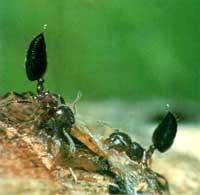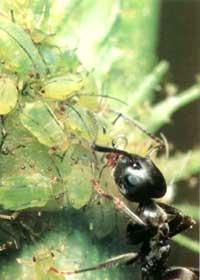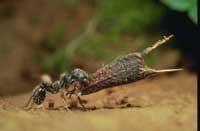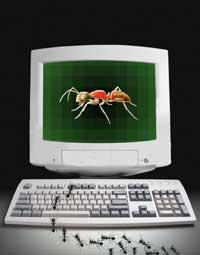From anthill to computers
Despite the tension, there is no discussion in the anthill. Somehow you have to go looking for food. Far away are the sugar hills, but the road is not easy. To assist you must overcome the stream. Less bad that there is a bridge. But the bridge is shaped like an irregular "Y". One branch is at least four times longer than the other and ants know they won't get enough sugar if they don't go the shortest way.
Such
problems arise not only in concrete mixers, but also in the human macromunda. How can you make the shortest way in an effective way? Scientists stop thinking and focus on real ants. They have found a good solution.

Without knowing the most direct path, all ants leave at once. Each individual, guided by his intuition, will advance from wherever he wishes. In this way, each and every road will be worked, including the most suitable and the worst. The strategy of ants is to mark the best way for all carriers to use it. Pheromones (chemical compounds) are emitted at crossings to mark the road. In principle all roads will mark, of course. How to know what is best? Those who
have gone the shortest way take the sugar and make the way home faster than others. This path will therefore be the first to mark twice. Those who come from behind only have to follow the most marked path to accelerate the displacement. The first "explorers" have found the solution to the problem of the return. It is not a bad idea.
Back in the laboratory
To
analyze the method, scientists have taken the anthills to the laboratory and have carried out numerous tests through different artificial pathways. However, the method sometimes fails. And it is that to achieve a safe success, the longer path has to be at least twice the rest. If they are similar, ants will not always decide well. In addition, if by chance the longest road is marked, the entire colony will accept it.

Scientists have invented other kinds of tests. Ants are hiding the shortest path until the first explorations end. In this case ants mark the longest path and consider it definitive. Although scientists have a shorter path, ants change their behavior.
But there is something else to consider. Chemical signals emitted do not last forever, as pheromones evaporate. When rapid evaporation occurs, the colony must frequently update the way to food. In these cases it is difficult to have long continuous markings and gradually the shortest path is chosen. This test is a very useful strategy in nature, since the appearance of the playing field can have many changes.
Theoretical ants
Direct application of strategy of ant colonies is a known problem of the seller. The seller must sell his product in several cities. As soon as you enter the car you have to organize the trip well, which city you are going to visit at the beginning, where you will go and how you will complete the trip without spending twice in the same city. The last condition of the trip is that it must end in the starting city.
Computer ants design trips with cyber pheromones poured into the crosses taken. To complete the journey, ants tend to choose the most marked direction at crosses. In this way, opportunities are discarded little by little effective. In addition, the computer eliminates pheromones left at crossings so that efforts are not strengthened by chance.

There are computer programs that when starting to detect a solution change the initial conditions and make more sessions. This has resulted in very fast and competitive methods in studying such problems. In fact, these programs are also useful in continuously evolving systems. Even if it is a despicable solution, all crossings directions have at least a small pheromone level. This is the adaptation capacity of the methodology.
The ants method has important applications in real life. For example, in the Swiss region in Italian it is used to indicate the origin of trucks that transport gasoline and, in general, to treat problems related to the means of transport.
Other ant tricks
There are many real problems with the right features to use the shortest path search. In addition, they can be translated into computer language. However, in some cases this methodology fails, especially when options are similar. The basis of such methods is statistical search. For example, the observed method uses pheromone concentration statistics.
But in real life unforeseen arise. Let's go over the ants that are bringing food. They have found the shortest way and are working effectively. But suddenly a storm begins and the rain turns the shortest road into dangerous. Every drop of water falling from the sky can kill a couple of ants. Those in the unprotected area have stagnated and there is great confusion. The rear ants have begun to push and someone is working on the path initially discarded.
Over
time, the longest path is protected, so pheromones have proliferated and the colony has chosen this path. Adaptation of the strategy. Once there, most ants will go to the shortest path. Doesn't it look the same as traffic problems?

The
main resource is the information that each individual transfers to the network crossings of this routing system. Everyone's experience is small, but it reflects the general trend. Although in the case of traffic, it is essential to take into account the evaporation of pheromones. Otherwise, there is a risk that information will become obsolete. These
types of strategies are very useful for urban traffic control. Algorithms are also used which consider that the information contained in the crosses may be deteriorated. In addition to traffic, they are very suitable systems to manage the transport of information in computer networks.
Social insects, an example for everything
Another system Scientists The |
Published in the supplement Natura de Gara
Buletina
Bidali zure helbide elektronikoa eta jaso asteroko buletina zure sarrera-ontzian











